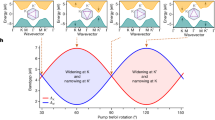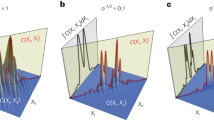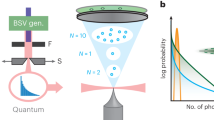Abstract
In 1982, Capasso and co-workers proposed the solid-state analogue of the photomultiplier tube, termed the staircase avalanche photodiode. Through a combination of compositional grading and small applied bias, the conduction band profile is arranged into a series of steps that function similar to the dynodes of a photomultiplier tube, with twofold gain arising at each step via impact ionization. A single-step staircase was previously reported but did not demonstrate gain scaling through cascading multiple steps or report noise properties. Here we demonstrate gain scaling of up to three steps; measurements show the expected 2N scaling with the number of staircase steps, N. Furthermore, measured noise increased more slowly with gain than for photomultiplier tubes, probably due to the lower stochasticity of impact ionization across well-designed heterojunctions as compared with the secondary electron emission from metals. Excellent agreement was found between the experiments and Monte Carlo simulations for both gain and noise.
This is a preview of subscription content, access via your institution
Access options
Access Nature and 54 other Nature Portfolio journals
Get Nature+, our best-value online-access subscription
$29.99 / 30 days
cancel any time
Subscribe to this journal
Receive 12 print issues and online access
$209.00 per year
only $17.42 per issue
Buy this article
- Purchase on Springer Link
- Instant access to full article PDF
Prices may be subject to local taxes which are calculated during checkout






Similar content being viewed by others
Data availability
The data that support the plots within this paper and other findings of this study are available from the corresponding author on reasonable request. Source data are provided with this paper.
Code availability
Simulation software used to produce electrostatic models are available at the following GitHub repository: https://github.com/scott-maddox/openbandparams.
Change history
15 June 2023
A Correction to this paper has been published: https://doi.org/10.1038/s41566-023-01249-2
References
Engstrom, R. W. et al. Photomultiplier Manual (RCA Corporation, 1970).
Iams, H. & Salzberg, B. The secondary emission phototube. Proc. IRE 23, 55–64 (1935).
Morton, G. A. Photomultipliers for scintillation counting. RCA Rev. 10, 525–553 (1949).
Hadfield, R. H. Single-photon detectors for optical quantum information applications. Nat. Photon. 3, 696–705 (2009).
Yalow, R. S. & Berson, S. A. Assay of plasma insulin in human subjects by immunological methods. Nature 184, 1648–1649 (1959).
Phelps, M. E., Hoffman, E. J., Mullani, N. A. & Ter-Pogossian, M. M. Application of annihilation coincidence detection to transaxial reconstruction tomography. J. Nucl. Med. 16, 210–224 (1975).
The ATLAS Collaboration. The ATLAS experiment at the CERN Large Hadron Collider. J. Instrum. 3, S08003 (2008).
Suzuki, Y. & Satellite, K. The super-Kamiokande experiment. Eur. Phys. J. C 79, 298 (2019).
Giacconi, R., Gursky, H., Paolini, F. R. & Rossi, B. B. Evidence for X-rays from sources outside the solar system. Phys. Rev. Lett. 9, 439–443 (1962).
Zworykin, V. A., Hillier, J. & Snyder, R. L. A scanning electron microscope. Bull. Am. Soc. Test. Mater. 117, 15–23 (1942).
Hell, S. W. & Wichmann, J. Breaking the diffraction resolution limit by stimulated emission: stimulated-emission-depletion fluorescence microscopy. Opt. Lett. 19, 780 (1994).
König, K. Clinical multiphoton tomography. J. Biophoton. 1, 13–23 (2008).
Photomultiplier Tubes: Photomultiplier Tubes and Related Products (Hamamatsu Photonics, 2016).
Bay, Z. & Papp, G. Determination of the probability distribution of the number of secondary electrons. IEEE Trans. Nucl. Sci. 11, 160–168 (1964).
Prescott, J. R. A statistical model for photomultiplier single-electron statistics. Nucl. Instrum. Methods 39, 173–179 (1966).
Lachs, G. The statistics for the detection of light by nonideal photomultipliers. IEEE J. Quantum Electron. 10, 590–596 (1974).
Campbell, J. C. et al. Recent advances in avalanche photodiodes. IEEE J. Sel. Top. Quantum Electron. 10, 777–787 (2004).
McIntrye, R. J. Multiplication noise in uniform avalanche diodes. IEEE Trans. Electron Devices 13, 164–168 (1966).
Matsuo, K., Teich, M. C. & Saleh, B. E. A. Noise properties and time response of the staircase avalanche photodiode. IEEE Trans. Electron Devices 32, 2615–2623 (1985).
Teich, M. C., Matsuo, K. & Saleh, B. E. A. Excess noise factors for conventional and superlattice avalanche photodiodes and photomultiplier tubes. IEEE J. Quantum Electron. 22, 1184–1193 (1986).
Chin, R., Holonyak, N., Stillman, G. E., Tang, J. Y. & Hess, K. Impact ionisation in multilayered hetero junction structures. Electron. Lett. 16, 467–469 (1980).
Williams, G. F., Capasso, F. & Tsang, W. T. The graded bandgap multilayer avalanche photodiode: a new low-noise detector. IEEE Electron Device Lett. 3, 71–73 (1982).
Capasso, F., Tsang, W. T. & Williams, G. F. Staircase solid-state photomultipliers and avalanche photodiodes with enhanced ionization rates ratio. IEEE Trans. Electron Devices 30, 381–390 (1983).
Ripamonti, G. et al. Realization of a staircase photodiode: towards a solid-state photomultiplier. Nucl. Instrum. Methods Phys. Res. A 288, 99–103 (1990).
Toivonen, M., Salokatve, A., Hovinen, M. & Pessa, M. GaAs/AIGaAs delta-doped staircase avalanche photodiode with separated absorption layer. Electron. Lett. 28, 32–34 (1992).
Czajkowski, I. K., Allam, J. & Adams, A. R. Role of satellite valleys in ionisation rate enhancement in multiple quantum well avalanche photodiodes. Electron. Lett. 26, 1311–1313 (1990).
Tsuji, M., Watanabe, I., Makita, K. & Taguchi, K. InAlGaAs staircase avalanche photodiodes. Jpn. J. Appl. Phys. 33, L32–L34 (1994).
Lambert, B. et al. Feasibility of 1.5 µm staircase solid state photomultipliers in the AlGaSb/GaInAsSb system. Semicond. Sci. Technol. 11, 226 (1996).
Vaughn, L. G., Dawson, L. R., Xu, H., Jiang, Y. & Lester, L. F. Characterization of AlInAsSb and AlGaInAsSb MBE-grown Digital Alloys Vol. 744, 397–408 (MRS Online Proceedings Archive, 2002).
Maddox, S. J., March, S. D. & Bank, S. R. Broadly tunable AlInAsSb digital alloys grown on GaSb. Cryst. Growth Des. 16, 3582–3586 (2016).
Woodson, M. E. et al. Low-noise AlInAsSb avalanche photodiode. Appl. Phys. Lett. 108, 081102 (2016).
Yi, X. et al. Extremely low excess noise and high sensitivity AlAs0.56Sb0.44 avalanche photodiodes. Nat. Photon. 13, 683–686 (2019).
Ren, M. et al. AlInAsSb separate absorption, charge, and multiplication avalanche photodiodes. Appl. Phys. Lett. 108, 191108 (2016).
Jones, A. H., March, S. D., Bank, S. R. & Campbell, J. C. Low-noise high-temperature AlInAsSb/GaSb avalanche photodiodes for 2-μm applications. Nat. Photon. 14, 559–563 (2020).
Zheng, J. et al. Characterization of band offsets in AlxIn1–xAsySb1–y alloys with varying Al composition. Appl. Phys. Lett. 115, 122105 (2019).
Bank, S. R. et al. Avalanche photodiodes based on the AlInAsSb materials system. IEEE J. Sel. Top. Quantum Electron. https://doi.org/10.1109/JSTQE.2017.2737880 (2018).
Ren, M. et al. AlInAsSb/GaSb staircase avalanche photodiode. Appl. Phys. Lett. 108, 081101 (2016).
David, J. P. R. Photodetectors: the staircase photodiode. Nat. Photon. 10, 364–366 (2016).
Maddox, S. J. et al. Low-noise high-gain tunneling staircase photodetector. In 2016 74th Annual Device Research Conference (IEEE, 2016).
Bude, J. & Hess, K. Thresholds of impact ionization in semiconductors. J. Appl. Phys. 72, 3554–3561 (1992).
van der Ziel, A., Yu, Y. J., Bosman, G. & van Vliet, C. M. Two simple proofs of Capasso’s excess noise factor FN of an ideal N-stage staircase multiplier. IEEE Trans. Electron Devices 33, 1816–1817 (1986).
Maddox, S. J. et al. Enhanced low-noise gain from InAs avalanche photodiodes with reduced dark current and background doping. Appl. Phys. Lett. 101, 151124 (2012).
Sun, W. et al. High-gain InAs avalanche photodiodes. IEEE J. Quantum Electron. 49, 154–161 (2013).
Pilotto, A. et al. Optimization of GaAs/AlGaAs staircase avalanche photodiodes accounting for both electron and hole impact ionization. Solid State Electron. 168, 107728 (2020).
Shockley, W. & Pierce, J. R. A theory of noise for electron multipliers. Proc. IRE 26, 321–332 (1938).
Friis, H. T. Noise figures of radio receivers. Proc. IRE 32, 419–422 (1944).
Ferraro, M. S. et al. Position sensing and high bandwidth data communication using impact ionization engineered APD arrays. IEEE Photon. Technol. Lett. 31, 58–61 (2019).
Forrest, S. R. Performance of InxGa1–xAsyP1–y photodiodes with dark current limited by diffusion, generation recombination, and tunneling. IEEE J. Quantum Electron. 17, 217–226 (1981).
Hess, K. Advanced Theory of Semiconductor Devices (Wiley, 2000).
Ma, F. et al. Monte Carlo simulations of Hg0.7Cd0.3Te avalanche photodiodes and resonance phenomenon in the multiplication noise. Appl. Phys. Lett. 83, 785–787 (2003).
Yuan, Y. et al. AlInAsSb impact ionization coefficients. IEEE Photon. Technol. Lett. 31, 315–318 (2019).
van der Ziel, A. Noise in Solid State Devices and Circuits (John Wiley & Sons, 1986).
Acknowledgements
This work was supported by the Army Research Office and DARPA (contract no. W911NF-17-1-0065) and DARPA (contract no. W909MY-12-D-0008). We acknowledge use of Texas Nanofabrication Facilities supported by the NSF NNCI Award 1542159.
Author information
Authors and Affiliations
Contributions
S.D.M. and S.R.B. carried out simulations, crystal growth and materials characterization. A.H.J. and J.C.C. were responsible for device fabrication and experimental characterization. Analysis was performed by S.D.M. and A.H.J. S.D.M. and A.H.J. wrote the paper with assistance from J.C.C. and S.R.B. S.D.M., A.H.J., J.C.C. and SRB all contributed to the structure design.
Corresponding authors
Ethics declarations
Competing interests
The authors declare no competing interests.
Additional information
Peer review information Nature Photonics thanks M. Saif Islam and the other, anonymous, reviewer(s) for their contribution to the peer review of this work.
Publisher’s note Springer Nature remains neutral with regard to jurisdictional claims in published maps and institutional affiliations.
Supplementary information
Supplementary Information
Supplementary Figs. 1–8 and Discussion.
Source data
Source Data Fig. 2
Impact ionization, band diagrams, gain distributions, source data.
Source Data Fig. 3
Measured and simulated staircase gain.
Source Data Fig. 4
Fit-to-measured staircase gain and excess noise.
Source Data Fig. 5
Staircase excess noise compared to conventional APDs and PMTs.
Source Data Fig. 6
Estimated SNR performance comparing staircase APD to conventional APDs.
Rights and permissions
Springer Nature or its licensor (e.g. a society or other partner) holds exclusive rights to this article under a publishing agreement with the author(s) or other rightsholder(s); author self-archiving of the accepted manuscript version of this article is solely governed by the terms of such publishing agreement and applicable law.
About this article
Cite this article
March, S.D., Jones, A.H., Campbell, J.C. et al. Multistep staircase avalanche photodiodes with extremely low noise and deterministic amplification. Nat. Photonics 15, 468–474 (2021). https://doi.org/10.1038/s41566-021-00814-x
Received:
Accepted:
Published:
Issue Date:
DOI: https://doi.org/10.1038/s41566-021-00814-x
This article is cited by
-
Avalanche photodiode with ultrahigh gain–bandwidth product of 1,033 GHz
Nature Photonics (2024)
-
Infrared avalanche photodiodes from bulk to 2D materials
Light: Science & Applications (2023)
-
On the unusually high photosensitivity of two barrier structures
Applied Physics B (2023)



